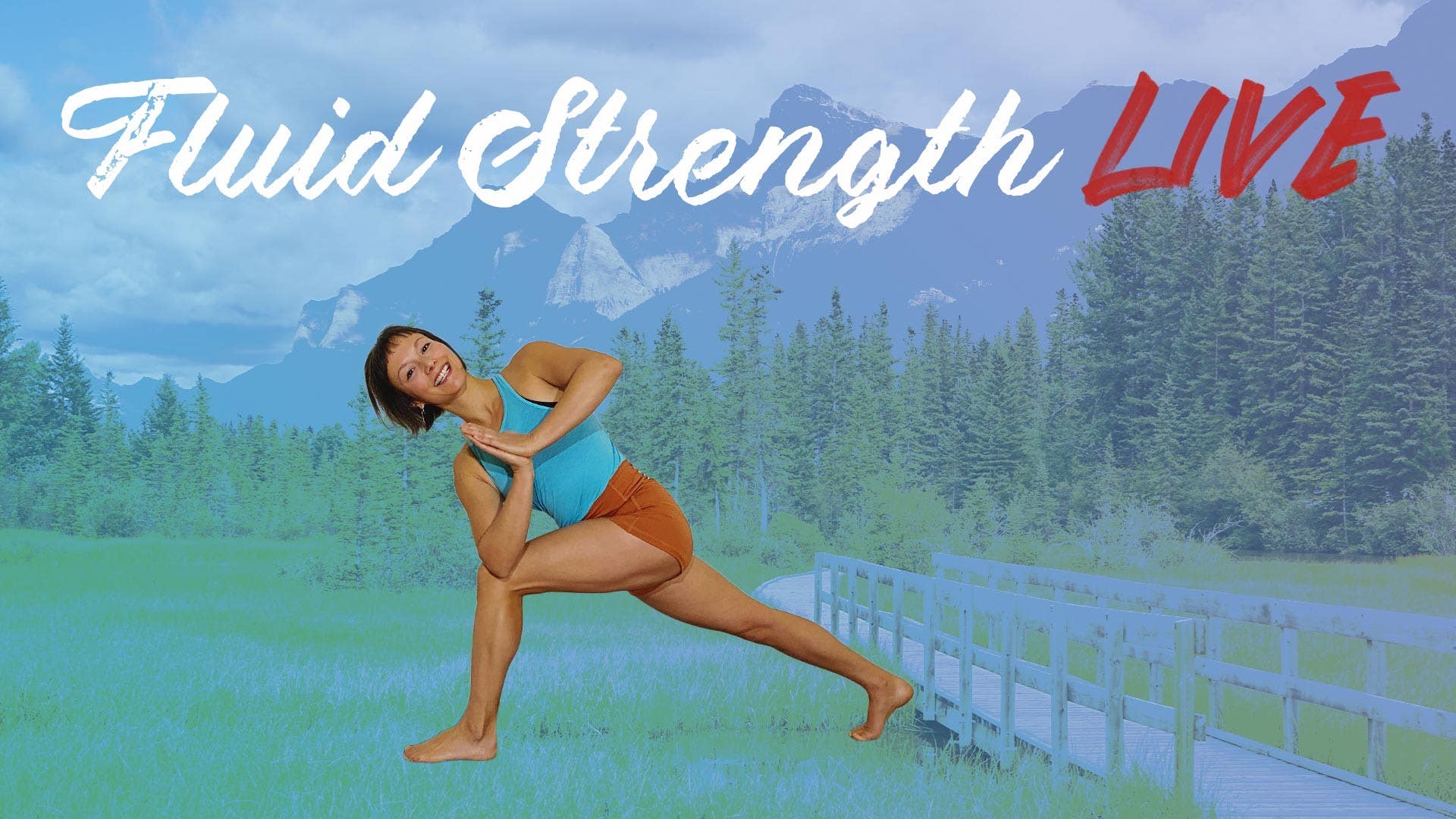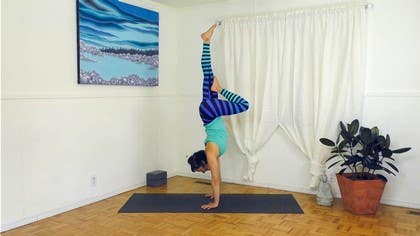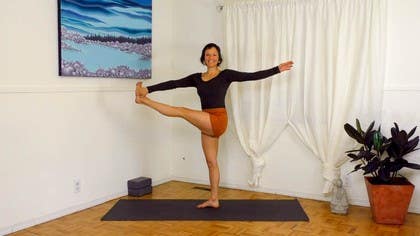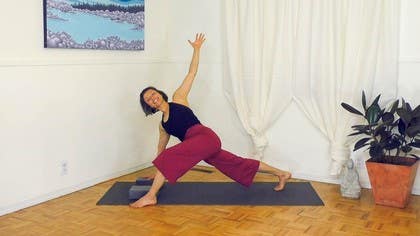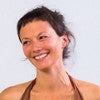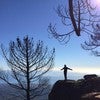Description
About This Video
Transcript
Read Full Transcript
Welcome to your practice today, your fluid strength practice. Today I'm excited to share with you a focusing and balancing sequence that could be good for grounding but also honing in on your energy and bringing some more clarity to whatever it is that you'd like to do. I want to mention that if you have two blocks for postures like Half Moon, you like to have those. Take those at the top of your mat. And also, if you like a little height under your seat, we're going to start in a seat with a little bit of breath work. So grab that and come up a little higher in your comfortable cross-legged position.
Slide your hands a little up your thighs. Roll your shoulders up, back, and down, and let the back of your body drop down towards your sit bones. Tuck your chin a couple of degrees. Maybe that makes your gaze fall down towards the floor. And then start equal length breathing. So breathe in for five counts, your five counts, your timing, and breathe out for five. It might feel natural to close your eyes. However, you could also keep them open, soft, maybe even taking in some peripheral vision. Feeling your own breath, your own seat, and your own practice here.
Five counts in, five counts out, couple more rounds. When we bring attention to the breath, we kind of go underneath the mind. The mind is a muscle grabbing things and pushing things away. And tune into a place of grounding that's always there for us. Beautiful. Let's take one hand out to the side and circle the other arm out, up and over into a beautiful side stretch. And you can drop your elbow if you want. Come into this at any extent you'd like to.
And look around your room. Just notice what you're doing with your eyes, how you're seeing. And then find a place that you want to rest your gaze, where your drishti, drishti means to see, and steady it there for a couple rounds of breath. Nice. Let's come on up into the center, catch the middle, and then come over to the other side. Circle your right arm up, out and over. And look around. That looking around might coincide with some movement in your body, exploring. Feeling that you're here. And then find a place that you want to steady your gaze, your drishti, and take a couple rounds of breath.
Easing into your practice today. Use that top arm to help you come up, catch the middle. Nice. And come onto your hands and your knees facing the front of the mat. You can take that prop out of the way. And point your middle, your index fingers rather, straight forwards. And start to shift forwards and back. With straight arms pushing the ground away.
If you like here, you can stay with this quadruped position or welcome to come into a plank and start to shift a little forwards and back. So you might even feel a nice stretch for the soles of your feet, for the wrists. For five, four, three, two, and one. Come on down into the center, if you're not already on your knees, and turn your hands out to the sides. So your middle finger points straight out laterally. So here you can again shift forwards and back on all fours.
Moving from the thumb side to the pinky side of the hand, or come into a plank, tuck your toes, find your long line through your spine, your head to your heels, and start to shift forwards and back with your arms as straight as you can. Steady your gaze for five, four, three, two, and one. And then come down onto the knees, any movements you'd like to unwind from that. Then we'll try taking our hands all the way around so the fingers point towards the knees. And either moving forwards and back in the quadruped position.
Steady your gaze. Your gaze could also be a little forwards if that helps your chest alignment. Or you could try taking one foot back, tucking the toes, keeping a little strength at your elbow joints, like you're trying to bend your elbows a little bit, and come into a plank and go forwards and back for five, four, three, two, and one. Slowly come back down onto your knees, can shake out your hands, and then we'll come into a downward facing dog with the index fingers pointing forwards. So tuck back through your toes, pedal out through your feet, and look around. So look around, move a little bit, let that looking, that curiosity and playfulness move you around, and then find some stillness and find a gazing point. So it could be right down in between your elbows.
Some people like to look up at the navel. Find a place that works for you and be still for a couple rounds of breath. Five counts in. Five counts up. Whole body involved here, five counts in. Five counts out. Beautiful, let's walk our feet to our hands.
You might tip toe, you can come up onto your fingertips there, lengthen out, fold in. Arms out to the sides, come all the way up, reach up, look up. Beautiful, release your arms. Sun Salutation A. Inhale, circle your arms up. Exhale, fold in, maybe big knee bend. Inhale, lengthen out.
Hands flat, step or hop your way to downward facing dog. Inhale to plank. Exhale to the ground. Inhale, maybe upward dog or cobra. Exhale, downward facing dog.
And then move around a little bit if you like, curiosity, playfulness, finding all those nooks and crannies in the body, shifting the structure left and right. And then practice being still for a couple rounds of breath. And then also steady your gaze. You might look at one spot and get interested in the texture of it. Or you might open up your peripheral gaze as you keep your eyes steady.
How are you seeing in your practice? Noticing that, how does that affect your mind? And then we'll come to the top of the mat, so you might hop, you might step. Exhale, fold in. Arms out and up, reach up.
Release your arms. Let's add a variation in, so arms up, look up, fold in. Lengthen out. Downward dog. Your choice on how to get there, beautiful.
Inhale to plank. Lower, maybe to chaturanga this time. Can take your knees down top, so the feet down and inhale, come into an upward dog. And then exhale, press into your hands, downward facing dog. You might use your knees in that transition too.
Let's inhale the right leg up to three-legged dog. And then exhale, tap the right toes back down to the floor. And then again, inhale the right leg up. And exhale it down for five, four. So you could keep your left heel on the ground or you could come off of it, depends.
Three, two, try to lift from your glute instead of from your low back. Last one here. And let's exhale our right knee towards our right wrist. Pleat the right toes, take your left knee down on the ground and untuck your left toes. And we'll start to come up into a high pigeon.
So you could use your blocks to support you here. Or you could reach your arms up and breathe here. See if you can lift out of your lower back. Your choice, your hips could slide a little closer to the floor. But this really uplifted position is a little stronger, a little longer maybe in your low back.
So you might look around a little bit, wiggle your fingers, get out of those crunchy spots. And then be still for a breath. Then we'll take our elbows out to the side, cactus the arms, drag the shoulder blades down the back. Take the hands behind, palms facing each other, and lean forward a little or maybe a lot. Here both sit bones feel like they're dragging to the back of the mat for five.
Four, strong right hip here. Three, two, and one. I know that's pretty strong. So we're going to come on back up and then exhale, hands are going to find the ground here. And as your hands find the ground, shift your right shin more vertical.
So aligned with the mat, take your left foot on an angle. So the outer edge of the foot is like in Warrior II. And circle your left arm up into a variation of side plank. So look around, you might coincide that with some movement. So there's some freedom, there's some play.
And then find a place to be steady. Also take your gaze somewhere and steady your gaze. Equal length breath in and out and noticing how that equal length breath and that steadiness of form and gaze, like what does that do to the mind? Just noticing. Okay, let's take our right arm down by our right hip, shift the right shin a little bit back behind us.
So there's a little more support to start to come up. We're coming up into like a stag position. And reach the right arm up and it's almost like you're going back into a warrior, a reverse warrior. You can have your left hand on your hip. It can be straight up or back.
Take a couple breaths into this. Press down through your foundation. And then we'll circle both hands to the floor. Turn the back foot into a tuck toe position and lift your right knee in towards your right armpit and then to the outside of your right hand for a twisted lunge. So back heel presses down, circle your right arm up.
You can also have your right hand on your right knee. Breathe into that. If you want to make this more challenging, pop up onto your left fingertips so you're really inhabiting your legs and less collapse in the upper body. Press into your back heel. Maybe even open up a little more. And then steady your gaze and steady your shape for a breath.
Nice. Let's take the right hand down to the floor. Then we're going to pop the left foot in so that it crisscrosses a little bit behind the right. And then sink into a toe squat. So with your back, your left leg, you're tucking your toes. And then come on up.
So strong in the legs, your choice. You can come on up and you're sort of hovering here. Your hands at prayer. Or if you want to take a twist, take your left elbow across to your outer right knee and press your hands together. The thing with this shape is that you're not collapsing down.
There's a little bit of a push down and lift of the hips. Beautiful. For another breath. Okay, let's slowly unwind from this fingertips pad the floor. Now take your left foot to the outside of your left hand. So now you're in a wide legged forward fold, top of the mat.
And exhale, fold in. Might play with straightening your legs a little bit more, shifting your weight into your toes. Letting your head drop. Letting your gaze steady, your drishti, the way you're seeing. You can come up a little bit onto your hands.
We're going to come into a squat. So your feet can be wide. Some people need to turn the toes out. Maybe the heels are off. Maybe they're down.
Take a breath in your squat. Allow your back to drop down to the ground. To make this more challenging, you could take your hands up alongside your ears. And then your hands can come down. It's your choice.
You can step back into your downward dog vinyasa. Or if you want, you can press into your hands either hot back, or if some of you are working with a press, you can work with a press there, or a hot back to your downward facing dog. And we'll inhale to plank. Exhale, lower. Knees down tops of the feet.
Inhale, loop open to your cobra or up dog. And then exhale, downward facing dog in your own way there. So we're doing our three-legged dog leg lift. So left leg up, inhale. Exhale it down.
So that's the plank. Inhale it up. You can be up on your right tiptoes, or your right heel can be grounded for more sensation in the back of your right leg. So we'll go for five. Press your arms towards straight.
Lift your right kneecap. And work from your left glute to lift the leg. Three. I love these, too. And one.
This time we're taking it through for a high pigeon. So left knee towards your left wrist. Point the left toes. Untuck your back toes. Maybe your blocks are handy here to come up a bit.
Or you can reach those arms right up. Lift out of your low back and push down through your foundation. You can look around, move around. Give yourself, always give yourself a large pastor to Roman. Freedom here.
And then there's some discipline as well, where we can invite ourselves to stay steady and breathe. And study with the gaze, study with the breath. Three. Lift out of that lower back. Two.
And one. So you might come forwards in this. Or actually let's cactus the arms first. So bring those elbows down. Squeeze the shoulder blades together.
Yes. And then come forwards. You might take your hands down if this is too strong in the hips. But if you can, both hips squeeze back. Have your hands as if they're squeezing a big beach ball in between them.
And breathe for three. Two. You're hovering those hips above the ground. Nice long spine like you're in a plank. And one.
Wow. That's a lot. Let's come on up. And then exhale the hands to the ground. And then we'll take our left leg slightly back and turn the shin more vertical.
And then take the outer right foot against the mat. Coming up into your side plank variation. So you can choose to have your arms straight up over your ear maybe. You can move around in this a little bit. Let your gaze move around the room.
Notice that you're here. Take it in. And then find some steadiness. Steadiness of the gaze, steadiness of the breath for five. Four.
Three. Two. And one. Beautiful. Let's take our right hand down.
Shift your shin so it's a little bit behind you. So it comes a little to the left. And then come on up. So it's like you're doing a reverse warrior in this shape. You can press down through your foundation, your foot, your knee.
And either lift straight up or a little bit back behind you. Putting your right hand on your right hip could also bend your right knee here. You could look up or look forwards. One more breath. I have Patrick Beach to thank for this interesting variation that I love.
And circle your hands back down to the mat. Turn your back toes so you're tucking your toes. And then lift your left knee up into your armpit and to the outside of your left hand. So we're coming into a twisted lunge. Taking the left arm either on the knee or up.
Let's take a couple breaths there. Strengthen through the legs. Beautiful. Might start by moving around a little more. And then find some steadiness for two breaths.
Could even pop up onto your right fingertips. Really inhabit the strength of your legs. Beautiful. Let's circle that left arm down and start to pad that right toe in. So it's tucking the toes and it's crisscrossing.
So your right knee actually comes to the outside of your left calf. And then coming up into a balance. So you're not collapsing in here. There's a little bit of a lift. If you want you can come into a twist.
Yeah. So I'm really using the power of my legs. Strengthening my legs as I press down and lift up a little bit. Maybe even push the hands together. Okay.
Hands down to the ground. Take your right foot now to the outside of your right hand. So you're in a wide legged forward fold. And then fold in. Press into your feet, the inner and the outer feet as you dangle forwards.
Now we'll come up onto our fingertips and come into a squat. So you might turn your feet out. You might come up off your heels, sink into that squat. If you want to make this more powerful, more challenging, take your arms up alongside your ears. Find a steady gazing point.
Let your tailbone drop. Let your back unravel here. And your hands can go down. So this might be a nice hopping place. Or you could step back through your downward dog Vinyasa.
If you want to hop, you could press down, hop up, back into your downward facing dog. Or you could play with a press handstand. So as you press into your hands, come up onto your tippy toes. Shift into your back body. Feel a little lift and back.
Downward facing dog. Inhale to plank. Exhale, lower. Upward dog, your choice on how you want to get into that or cobra. You can press into your hands or use your knees to take you back into downward facing dog.
Gorgeous. Step or hop to the top of the mat. And fold in. All the way up, reach. Release your arms.
Let's do that whole sequence again a little quicker this time. So arms up, reach, look up. Fold in. Lengthen out. Downward dog.
Inhale to plank. Lower. Your back bend. Your downward dog transition. Right leg up.
Five times. So one, from the glute. Two. Three. Four, maybe you're even gluing your left heel to the ground.
Five, lift up, take it through into your high pigeon. Knee towards the right wrist. Inhale, come up or use your blocks there. Take a breath there. Exhale, cactus your arms, drag your shoulder blades down your back.
Shift forward, squeeze your palms behind you and back for a breath. Both hips move evenly back. Inhale, come back up, high pigeon. Hands to the ground. Make your right shin more straight up and down.
Take the outer edge of your back foot and come into your side plank variation. Maybe your arm comes alongside your ear. Left hand down. Take your right shin a little behind you and then circle up into this warrior three variation, reverse warrior as your right arm comes up. Beautiful, you can go straight up and down or back behind you a little.
And then circle your hands to the ground. Turn onto your tucked back toes. Right knee into your right armpit for a breath. To the outside of your right hand, coming in towards your twisted lunge. So you can pop up onto your right fingertips.
If you really want to be in your legs there, right arm up, maybe behind you. Find your breath. If you want to try here, you could start to straighten your right leg and pull up on the kneecap. Maybe even take your right arm over your ear like an extended side angle and angle your torso a little away from your right hip. And circle that right hand down to the ground again.
Pop your left foot in to that crisscross squat. So your left knee to the outside of your right calf. Hands can be together at the front or twisting that. Beautiful. Take your fingertips to the ground.
Step your left foot wide so you're in a wide legged forward fold. Take a breath in there. Fold forwards. Inhale up. Let's come into your squat.
Choose your squat position. Maybe take your arms up. Steady your gaze. Hands to the ground you might hop. Press however you'd like to step back through your transition.
Downward facing. Blank. Lower. Your upward dog transition. Your downward facing dog.
Left leg up five times, one, two, three, four, and five. This time take it through to your high pigeon. Beautiful. Point the toes, untuck the back toe. Either use your blocks or come on up.
Lift out of your low back. Feel a compactness around your hips. Steady your gaze. Steady your breath. Cactus your arms.
Squeeze those shoulder blades together down your back. Then come forwards. Hips move straight back. It's like you're squeezing your hands, your palms in towards the midline. Even weight in both your shins.
Come on back up. High pigeon. Hands to the ground. Allow your left shin to be more in line with the sides of your mat. Come on to the outer edge of your right foot.
Come into your side plank variation. Maybe take your right arm alongside your ear. Take your right hand to the ground. Shift your left shin a little behind you. Circle up into like a warrior, a reverse warrior here.
Maybe your hand on your hip. Maybe your hand on your knee. Press down through your foundation to lift up through your spine. Feel the strength and the shape instead of a collapse. Beautiful.
Circle your hands down to the ground. Tuck your back toes like you're in a plank on your back leg. Left knee up into the left armpit. And then to the outside of your left hand. It can pop up onto your fingertips there.
Find your twisted lunge. So right hand might come on your right knee. It might come all the way up. Beautiful. You could straighten your left leg.
Tighten around your kneecap. And even take your body on a diagonal. Like you're leaning away and straighten your left arm. It's a beautiful variation. Circle back to the ground with your left hand.
You're coming to your wide legged forward fold right foot to the outside of the mat slightly. Dangle in. You are squat. You can shift around, look around. And then what does it feel like to stay steady?
There's no hierarchy here. So not one is better than the other. But linking the two. Hands can come to the ground, your choice, your hop, your step. Maybe you're starting a press.
We push into the hands, come up onto your tiptoes. Lean into your finger pads. Come up onto point on your tiptoes. Press into your hands. Feel a lift.
Back into your downward facing dog. Roll through to your plank. Lower down. Beautiful. Exhale.
Upward dog or cobra, your transition. And downward facing dog. Let's come to standing, step or hop. Lengthen out there. Fold in.
Come all the way up. And release your arms. So for a balancing sequence, just make sure your blocks are handy for a half moon. And I'm just going to turn to show you, let's take our left leg up first into tree. It's going to be below or above the knee.
Push the foot and the thigh together and find a place for your arms. So it's okay to look around in your balancing shape. That's actually testing your balance, as you can see when you do that. Try that. Maybe even move your shape like you're a tree in the wind.
And then stay steady. It's not a rigid steadiness, but a relaxation into steadiness. Steady or gaze. There, let your arms drop down a little bit. I'm just going to turn so you can see this transition.
Take your left knee up into your abdomen and hold it with your right hand. And then you can start to turn into a moonrise position. We'll call it that. Or you can take your outer left foot and kick it out. You can look around.
You can wiggle your fingers. You can find the buoyancy in your bottom leg. And then find a gazing point. It could be at the floor. It could be straight ahead.
It could even be up. And steady it for a couple breaths. Stay a little. Gorgeous. So we're going to turn it into a half moon, keeping the left leg the one that's going to be buoyant.
So transition here so that your right hand finds the ground, little to the right of your right foot, maybe the block. Your left leg lifts a little higher. Now, you can move around a little bit. You might even, some folks, like to hold the back ankle, find your shape, find your buoyancy, find your freedom, and then sort of stick into some steadiness. It's not rigid.
It's soft, but it's powerful. Okay, let's take the left hand down, start to move towards like a warrior three, and then crisscross your right foot behind your left. Take a breath in there, and we'll do a crisscross forward fold. Folding in, letting your head go. Seeing what happens when you press into the big toe mound.
Maybe shift the hips a little forwards. Then press into your heels. Take your arms out to the sides, push into your feet, come all the way up, release your arms. I'm just going to turn to the back of the mat for your view so it's a little easier for you to see. But we'll take tree with our right leg up.
So finding your tree, the inner and outer edge of your bottom foot, your arms open. You can look around, you can move it, you can even side bend your tree. Fun thing to do. Give yourself all that freedom, all that space. And then if you like, studying it for a couple breaths.
Even length, inhale and exhale. Letting your hands come down. And then we'll take that transition, where we let our right knee come in towards the abdomen and hold it with your left hand on the outer knee. Start to come into a twist, perfect. Always have the option of holding the outside of the foot.
Look around, wiggle your fingers, move. Feel some softness, feel the whole body working to make this happen. And then steady your gaze. Steady your breath. Beautiful.
Let's slowly transition, it's half moon transition. So you're floating on that left leg, coming on down to find your block, or your fingertips on the floor to the outside of the foot. Maybe your right leg lifts a little higher, you're always welcome to give yourself that extra quad stretch if you want, by holding the outside of your right foot. You can look around, and that's challenging to look around in this one. Then steady it.
Just like we popped up on the fingertips in that twisted lunge, can you kind of pop up onto your fingertips so you're inhabiting your legs a little more. Steady gaze for at least a breath. Let's catch that warrior three. Belly button down towards the floor, and then right foot goes behind the left. Well, inhale, come up halfway.
You can bend your knees a lot in this one. Exhale, crisscross fold. Feel your neck unravel. Like when you drop a set of blinds, let the neck fall to the ground. Shift your hips a little more over your toes, press into your big toe mound.
Beautiful. Come up a little bit, weight your heels, arms out to the sides. Come all the way up, and release your legs. Let your hands come down by your sides. Top of the mat there, let's inhale, circle our arms up, coming to the ground now, folding in.
Lengthen out your downward dog. Inhale to your plank, maybe all the way to the ground or hover. Your knees can come down, your feet can come down. Find your upward dog. And then press into your hands, protract those shoulder blades, widen them, and step back to downward facing dog.
And then we'll hop or step however you'd like through to a seat. And find your seat. Let's stay on our right leg, our right leg straight, and take our left leg into Janu Shishasana. You might want to put something underneath your hips. Walk your sit bones back either.
You can also put a block underneath your left knee. And then tip your pelvis forwards and slide forwards for Janu Shishasana. Inner foot finds the inner leg, or you could also have it where the sole of the foot even points up. That would be a little bit more stretch through the hip and through the back. If you want to make this a little more challenging, you can float your arms, reach them forwards, press your foundation down, or of course, hold your foot or grab a wrist.
Look around, move around. Notice where you are. Your freedom, your practice, yourself. Knowing how you want to move. And then where do you want to stay steady?
Sometimes it's nice to look at your big toe, or look at the floor in front, find a place to steady, and stay a little. Let's come on up from that, weighting the sit bones, coming into a Marichasana, twist, so a half squat can hook your hand across and start to turn left fingertips on the ground. Of course, you can twist a bit more and take your elbow to the outside of the knee, maybe even your outer shoulder. Thumb down, if you'd like to find a bind there, can find a bind. Whatever works to keep your collarbones alive and open, a feeling of a twist and lengthen through your spine.
And look around, get your shape just right, and then steady it for a breath. If you're in that bind, unravel from that, take the outside of your left foot, and lean back a little, and start to kick that left leg out towards straight. Yeah, so you could stay there. You could bring it in more in towards you. You could even circle your left arm up, so you crisscross your hands around your foot, and draw the leg in towards you for a breath.
Okay, let's let that leg come down. Bend your legs, take your hands behind you. Choose if you want to have your tabletop with your fingers towards you or away from you, and roll your collarbones up towards your face. Slide your shoulder blades down, press into your hands and your feet, and come up into your tabletop. Let's take a couple breaths.
You might keep your chin tucked if you've got neck stuff going on, or you could check out if your head can fall back sort of in the pillow of your trapezius there. Look up. And then we'll do a little strength work here, where you drop your hips a little, keep pressing into your hands quite strongly, and see if you can hover your hips above the floor. It might be nice to take that blanket out. Hover your hips above the floor.
Maybe lift one leg up, hips are floating, pressing into your hands strongly. Maybe lift both legs up to a little L-sit position, and then shift it back forwards, back up into a tabletop, and then hips to the ground. I'm going to take that blanket back under. You might want to do that. Left leg straight, right leg into Janu Shishasana, and you might choose to have the sole of the foot towards the inner thigh, or maybe turn the sole of the foot up and widen the knee a little more out to the side.
Turn towards your left leg, walk your sit bones back, tip your pelvis, and fold in. So you can move a little in this. Find your own way of moving, your own expression of this shape, your freedom. You're getting to know yourself here, maybe even making it more challenging by reaching your hands forwards. Hands drop, come on up.
Coming into that half squat, foot close to the sit bone, right hand behind, so you can hook and turn. You can turn the abdomen more and hook your elbow outside. You can take your armpit to the outside, thumb down, and wrap it around and find a bind if you like. Lots of space in your collarbones. Moving around a bit there if you like, and maybe you'll find a steady place to look.
And it doesn't have to be so serious, right? It's an exploration of staying a little in a place, noticing what you see. Let's come on forwards, and take the outside of your right foot with your left hand, kick it up, maybe lean back a little more. You might want to stay there with your knee bent, bring the leg a little in towards you if you like, maybe a big circle over, clasp the inner foot, draw it in towards you. And releasing that out, let's come into our tabletop, so it might be worth moving the blanket out to the sides.
Bend your legs, choose how you want your hands to situate, lift the collarbones, drop your shoulder blades, lift up, maybe let your head go back, press into your hands and feet. Let's try that strength work again, so keep pressing your arms towards straight, shift your hips towards your hands. Keep pressing, you might even curl a little bit. You might lift one leg up and stay there, easing your triceps, the backs of your arms to the bones. You might keep shifting your hips back, come forwards, and try to lift both legs off the ground for a breath, pushing into your hands.
And then forwards again, back into your tabletop, lift those collarbones, lift up, and release your seat. Beautiful, let's shift forwards, roll out through the wrists, and coming to a forward fold, maybe hide underneath your hips with your right leg crossed over top of your left, so it's a crisscross forward fold this time. You can walk your sit bones back, tighten around your kneecap slightly, and start to fold in. Just like we do those three-legged dog leg lifts, you might want to come in and come out a few times, like five times, or you might shift in and stay. So give yourself freedom to move.
If you like, find some steadiness, find a gazing point, and take a couple breaths. If you want to make this more challenging, of course you can reach your arms forwards and push down through your legs. And then weight your sit bones, drop your hands, come on up. Let's switch. So our left foot is on top of our right.
So starting to fold in, you might shift forwards and up, up to five times if you like. And then if you like, fold in and stay. Maybe you're reaching your arms. And sit bones heavy, hands down. Let's come on up.
Beautiful. And we're going to shift onto our back for a few plow rolls. So rolling onto your back body. And then hands flat. Let's roll our knees in towards our face, and then roll them down slowly, pressing into your hands so you can feel the backs of your arms working.
So you can roll your hips up any amount a little, or maybe a lot, maybe right into a plow. And then press into your hands and roll slowly down, even one vertebra at a time. And you can tap your feet to the ground, knees bend, and then move your legs towards straight, roll on up, and slowly lower down. Beautiful. Now you can even do this slightly to the side.
So you can press in and take your knees slightly to your right, and then press into your hands and roll on down. Tap your feet to the floor, and then you can even move your knees slightly to the left. So you're more on the left side of your spine. Press into your hands. Slow motion.
Roll on down. Let's do that a few more times, maybe a little right. Slow motion lower. Maybe a little left. Slow motion lower.
Now up to you, you can keep doing that, or you can roll on up and either support your hips. Your hips can be far away from your face so that there's not so much pressure on your neck. Maybe your toes come to the floor. They can separate even. But you're not on the base of your neck here.
You're just below that. Maybe you even take your hands over your head and hold your toes. And test out how that feels for a couple breaths. Try to keep your lower back nice and long. And then you're welcome to keep your arms over your head or if you need the support, hands down by your sides.
Push and slowly lower yourself down. Draw your knees in towards your chest. Squeeze them in. Take a couple floating twists with your arms out to the sides. Let your knees fall left and right.
And then we're coming to our shavasana. So set yourself up. You might keep your feet planted or outstretch your legs. And we'll come back for a few rounds of some of Riti breath. So five counts in.
Take your time to get settled. Five counts out. Five counts in. Five counts out. If your eyes are closed, open them just for a moment and take in a steady focus point and then let your peripheral vision open so you can take in the whole room or wherever you're practicing.
Stay a little there. And then if you feel safe for you, close your eyes. Notice how you feel and attend to yourself here. Noticing how the practice allows you to be more of yourself where you step into that because you give yourself freedom. You get to know yourself more.
Check in. It might be worth noting that if you're not connecting in and perhaps not being who you really are, that's coming away from the present moment. So any connection you have with yourself here, lean into that. Thank you.
Fluid Strength
Comments

You need to be a subscriber to post a comment.
Please Log In or Create an Account to start your free trial.
